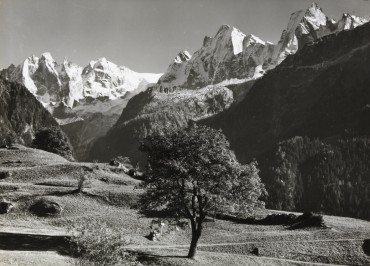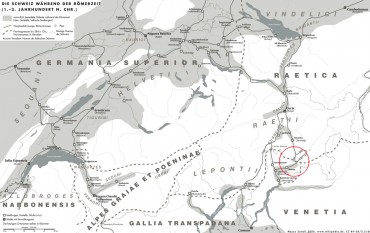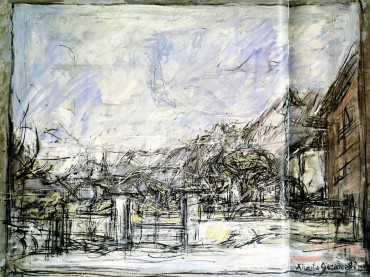Selected Topic
Issue 3 - On Giacometti – Physical and Cultural Landscapes in the Bergell (June 2011)
Show articles
1. View to Sciora-Gruppe, Piz Cengalo and Piz Badile, Otto Furhter Verlag.

2. Maloja-Pass, Scheiegger-Spliess Verlag 1997, Ernst Scheidegger.

3. Historic Map of Switzerland 100-300 AD, Marco Zanoli 2006.

4. Village Stampa, Foto Bernhardt, Huttwil.

5. Landschaft bei Stampa, 1952. Alberto Giacometti. Bündner Kunstsammlung Chur.

6. Borgonovo cemetery, Scheiegger-Spliess Verlag 1997, E. Scheidegger.
4.7.2012 – Issue 3 - On Giacometti – Steinemann Ramias – Studio, Essays
Cultural Landscape - Val Bregaglia and the Giacomettis
by Ramias Steinemann
The home of the Giacometti’s, the Val Bregaglia is an Italian speaking valley on the south side of the Alps expanding in an extremely deep drop from the heights of the Maloja and the Septimer pass towards south to the Italian border ending in the lowlands of North Italy in Chiavenna. The topographic transition between the world famous Engadin valley and the Val Bregagli forms also the water divide between the river “Inn” and the “Maira”: eastward the river “Inn” flows, passing St. Moritz and ends in the Black sea while to the west the “Maira” crosses Val Bregaglia and ends in the Adria. In former times the upper part of the Val Bregaglia was part of the “Inn” Valley until the “Maira” draining southwards carved into the ground of the valley with enormous erosion. The Landscape and Flora changes spectacularly on a small distance from alpine mountains around Maloja over to the deep and mild air of the north of Italy. Sinking down through into the Val Bregaglia the blue sky and the sun of the Lombardei glimmers behind the eternal Snow of the Sciora Mountains. (1,2)
Historically the Val Bregaglia was a part of Gallia Cisalpina Transpadana. Around the first century AD under the prefecture of Como the Romans invested in streets connecting the north with the south of the Alps. These reinforced passes between the Germans and the Romans increased the importance of alpine transit valleys. After new passes such as the Gotthard and the Splügen were built in the 19th century the Val Bregaglia lost again its favourable commercial position and was forced to focus income again more on agriculture.
A historical fact which affected the ancestors of the Giacometti was the religious orientation of the valley orientating towards the north quite early: first in 960 when they were split from Como in a swap towards the bistum of Coire, than they passed over completely as the only valley of the south of the Alps in the reformation. By evolving into the “3 Bünde” they became independent from Coire and took Italian religious refuges such as the ancestors of the Giacometti’s. (A witness of the enthusiastic reformation was the "Bildersturm" in the San Gaudenzio Church in Cassacia in 1551). (3)
Another rather specific character of the Valley of meaning for the Giacometti’s was the economically driven emigration, which had its beginning in the different pest epidemics around 1350 to 1460 and lasted until the 19th century. Being extremely successful especially as bakers glazers in the beginning only in Venice than over the whole of Europe, they often returned back to their origins rich and wealthy. Many Palazzis or castles display path. The grandmother on the mother side of Alberto Giacometti’s from the family Baldini owned a famous bakery in Marseille. The father of Giovanni Giacometti was also a successful baker.
The Landscape and the history were influential to the art, especially to Alberto Giacometti’s. Just standing literally in the shadow of the light of the famous Engadin, where Tourism and Art were uprising in this open valley with the champagne climate since the middle of the 19th century. Artist like Giovanni Segantini, Ferdinand Hodler and poets like Hermann Hesse and especially Nitzsche “Stück Ober-Erde” were celebrating this metaphysical landscape. In contrast to that fountain of youth of the Engadin the family of the Giacometti’s lived as artist in the harsh surrounding of the Val Bregaglia, where the living is made by farming and were in winter the shadow lies permanent on the bottom of the valley. (4)
Nevertheless or more probably because of the unique origin, the family of the Giacometti’s stayed both physically and with their pictured motives close connected to the “Val Bregaglia”. Alberto while living in Paris always returned back every year for several months to live and work in the Atelier in Stampa. In contrast to his father Giovanni and his uncle Augusto representing the specific conditions of light and nature with spectacular perspectives, Alberto often chose banal viewpoints out of the windows to capture the traces of reality. (5) The same tradition of the relatedness to family and geographical origin continues with the “tomba di famiglia” in the cemetery of the San Giorgio in Borgonovo, the neighbour village of Stampa. (6)
Download article as PDF

